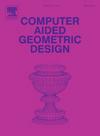Curvature continuous corner cutting
IF 1.7
4区 计算机科学
Q3 COMPUTER SCIENCE, SOFTWARE ENGINEERING
引用次数: 0
Abstract
Subdivision schemes are used to generate smooth curves by iteratively refining an initial control polygon. The simplest such schemes are corner cutting schemes, which specify two distinct points on each edge of the current polygon and connect them to get the refined polygon, thus cutting off the corners of the current polygon. While de Boor (1987) shows that this process always converges to a Lipschitz continuous limit curve, no matter how the points on each edge are chosen, Gregory and Qu (1996) discover that the limit curve is continuously differentiable under certain constraints. We extend these results and show that the limit curve can even be curvature continuous for specific sequences of cut ratios.
曲率连续切角
细分方案用于通过迭代细化初始控制多边形来生成平滑曲线。最简单的细分方案是切角方案,即在当前多边形的每条边上指定两个不同的点,然后将它们连接起来,得到细化多边形,从而切掉当前多边形的角。de Boor(1987 年)的研究表明,无论如何选择每条边上的点,这一过程总是收敛于一条 Lipschitz 连续的极限曲线,而 Gregory 和 Qu(1996 年)则发现,在某些约束条件下,极限曲线是连续可微的。我们扩展了这些结果,证明极限曲线甚至可以在特定的切割比序列中曲率连续。
本文章由计算机程序翻译,如有差异,请以英文原文为准。
求助全文
约1分钟内获得全文
求助全文
来源期刊

Computer Aided Geometric Design
工程技术-计算机:软件工程
CiteScore
3.50
自引率
13.30%
发文量
57
审稿时长
60 days
期刊介绍:
The journal Computer Aided Geometric Design is for researchers, scholars, and software developers dealing with mathematical and computational methods for the description of geometric objects as they arise in areas ranging from CAD/CAM to robotics and scientific visualization. The journal publishes original research papers, survey papers and with quick editorial decisions short communications of at most 3 pages. The primary objects of interest are curves, surfaces, and volumes such as splines (NURBS), meshes, subdivision surfaces as well as algorithms to generate, analyze, and manipulate them. This journal will report on new developments in CAGD and its applications, including but not restricted to the following:
-Mathematical and Geometric Foundations-
Curve, Surface, and Volume generation-
CAGD applications in Numerical Analysis, Computational Geometry, Computer Graphics, or Computer Vision-
Industrial, medical, and scientific applications.
The aim is to collect and disseminate information on computer aided design in one journal. To provide the user community with methods and algorithms for representing curves and surfaces. To illustrate computer aided geometric design by means of interesting applications. To combine curve and surface methods with computer graphics. To explain scientific phenomena by means of computer graphics. To concentrate on the interaction between theory and application. To expose unsolved problems of the practice. To develop new methods in computer aided geometry.
 求助内容:
求助内容: 应助结果提醒方式:
应助结果提醒方式:


